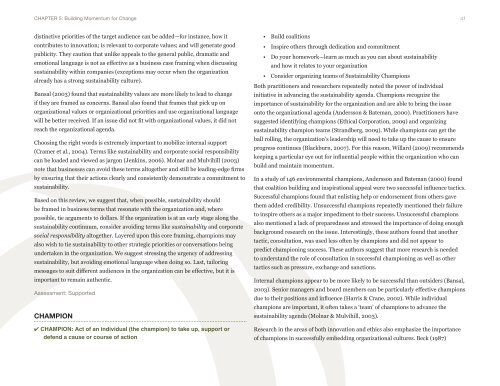embedding sustainability in organizational culture - Network for ...
embedding sustainability in organizational culture - Network for ...
embedding sustainability in organizational culture - Network for ...
Create successful ePaper yourself
Turn your PDF publications into a flip-book with our unique Google optimized e-Paper software.
Chapter 1: 5: Introduction Build<strong>in</strong>g Momentum <strong>for</strong> Change<br />
41<br />
dist<strong>in</strong>ctive priorities of the target audience can be added—<strong>for</strong> <strong>in</strong>stance, how it<br />
contributes to <strong>in</strong>novation; is relevant to corporate values; and will generate good<br />
publicity. They caution that unlike appeals to the general public, dramatic and<br />
emotional language is not as effective as a bus<strong>in</strong>ess case fram<strong>in</strong>g when discuss<strong>in</strong>g<br />
<strong>susta<strong>in</strong>ability</strong> with<strong>in</strong> companies (exceptions may occur when the organization<br />
already has a strong <strong>susta<strong>in</strong>ability</strong> <strong>culture</strong>).<br />
Bansal (2003) found that <strong>susta<strong>in</strong>ability</strong> values are more likely to lead to change<br />
if they are framed as concerns. Bansal also found that frames that pick up on<br />
<strong>organizational</strong> values or <strong>organizational</strong> priorities and use <strong>organizational</strong> language<br />
will be better received. If an issue did not fit with <strong>organizational</strong> values, it did not<br />
reach the <strong>organizational</strong> agenda.<br />
Choos<strong>in</strong>g the right words is extremely important to mobilize <strong>in</strong>ternal support<br />
(Cramer et al., 2004). Terms like <strong>susta<strong>in</strong>ability</strong> and corporate social responsibility<br />
can be loaded and viewed as jargon (Jenk<strong>in</strong>s, 2006). Molnar and Mulvihill (2003)<br />
note that bus<strong>in</strong>esses can avoid these terms altogether and still be lead<strong>in</strong>g-edge firms<br />
by ensur<strong>in</strong>g that their actions clearly and consistently demonstrate a commitment to<br />
<strong>susta<strong>in</strong>ability</strong>.<br />
Based on this review, we suggest that, when possible, <strong>susta<strong>in</strong>ability</strong> should<br />
be framed <strong>in</strong> bus<strong>in</strong>ess terms that resonate with the organization and, where<br />
possible, tie arguments to dollars. If the organization is at an early stage along the<br />
<strong>susta<strong>in</strong>ability</strong> cont<strong>in</strong>uum, consider avoid<strong>in</strong>g terms like <strong>susta<strong>in</strong>ability</strong> and corporate<br />
social responsibility altogether. Layered upon this core fram<strong>in</strong>g, champions may<br />
also wish to tie <strong>susta<strong>in</strong>ability</strong> to other strategic priorities or conversations be<strong>in</strong>g<br />
undertaken <strong>in</strong> the organization. We suggest stress<strong>in</strong>g the urgency of address<strong>in</strong>g<br />
<strong>susta<strong>in</strong>ability</strong>, but avoid<strong>in</strong>g emotional language when do<strong>in</strong>g so. Last, tailor<strong>in</strong>g<br />
messages to suit different audiences <strong>in</strong> the organization can be effective, but it is<br />
important to rema<strong>in</strong> authentic.<br />
assessment: Supported<br />
champion<br />
✔ chaMpion: act of an <strong>in</strong>dividual (the champion) to take up, support or<br />
defend a cause or course of action<br />
• Build coalitions<br />
• Inspire others through dedication and commitment<br />
• Do your homework—learn as much as you can about <strong>susta<strong>in</strong>ability</strong><br />
and how it relates to your organization<br />
• Consider organiz<strong>in</strong>g teams of Susta<strong>in</strong>ability Champions<br />
Both practitioners and researchers repeatedly noted the power of <strong>in</strong>dividual<br />
<strong>in</strong>itiative <strong>in</strong> advanc<strong>in</strong>g the <strong>susta<strong>in</strong>ability</strong> agenda. Champions recognize the<br />
importance of <strong>susta<strong>in</strong>ability</strong> <strong>for</strong> the organization and are able to br<strong>in</strong>g the issue<br />
onto the <strong>organizational</strong> agenda (Andersson & Bateman, 2000). Practitioners have<br />
suggested identify<strong>in</strong>g champions (Ethical Corporation, 2009) and organiz<strong>in</strong>g<br />
<strong>susta<strong>in</strong>ability</strong> champion teams (Strandberg, 2009). While champions can get the<br />
ball roll<strong>in</strong>g, the organization’s leadership will need to take up the cause to ensure<br />
progress cont<strong>in</strong>ues (Blackburn, 2007). For this reason, Willard (2009) recommends<br />
keep<strong>in</strong>g a particular eye out <strong>for</strong> <strong>in</strong>fluential people with<strong>in</strong> the organization who can<br />
build and ma<strong>in</strong>ta<strong>in</strong> momentum.<br />
In a study of 146 environmental champions, Andersson and Bateman (2000) found<br />
that coalition build<strong>in</strong>g and <strong>in</strong>spirational appeal were two successful <strong>in</strong>fluence tactics.<br />
Successful champions found that enlist<strong>in</strong>g help or endorsement from others gave<br />
them added credibility. Unsuccessful champions repeatedly mentioned their failure<br />
to <strong>in</strong>spire others as a major impediment to their success. Unsuccessful champions<br />
also mentioned a lack of preparedness and stressed the importance of do<strong>in</strong>g enough<br />
background research on the issue. Interest<strong>in</strong>gly, these authors found that another<br />
tactic, consultation, was used less often by champions and did not appear to<br />
predict champion<strong>in</strong>g success. These authors suggest that more research is needed<br />
to understand the role of consultation <strong>in</strong> successful champion<strong>in</strong>g as well as other<br />
tactics such as pressure, exchange and sanctions.<br />
Internal champions appear to be more likely to be successful than outsiders (Bansal,<br />
2003). Senior managers and board members can be particularly effective champions<br />
due to their positions and <strong>in</strong>fluence (Harris & Crane, 2002). While <strong>in</strong>dividual<br />
champions are important, it often takes a ‘team’ of champions to advance the<br />
<strong>susta<strong>in</strong>ability</strong> agenda (Molnar & Mulvihill, 2003).<br />
Research <strong>in</strong> the areas of both <strong>in</strong>novation and ethics also emphasize the importance<br />
of champions <strong>in</strong> successfully <strong>embedd<strong>in</strong>g</strong> <strong>organizational</strong> <strong>culture</strong>s. Beck (1987)
















